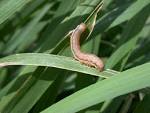Herald | Date: 13 February 2014>
 The rainy season, always welcome in often dry southern Africa, has brought with it favourable breeding conditions for army worms and red locusts. The crop-eating pests are contributing to the woes of subsistence farmers already struggling to recover from setbacks in the last farming cycle.
The rainy season, always welcome in often dry southern Africa, has brought with it favourable breeding conditions for army worms and red locusts. The crop-eating pests are contributing to the woes of subsistence farmers already struggling to recover from setbacks in the last farming cycle.
In Zimbabwe, where the World Food Programme estimates that 2,2 million people now require food assistance, more than 800 hectares of cereal grain crops and 300 hectares of pasture have been destroyed by outbreaks of army worms.
Godfrey Chikwenhere, Deputy Director of the Department of Research and Specialist Services in the Ministry of Agriculture, told IRIN that the damage caused by the army worms, which are in fact moth larvae, was significant and would impact the food security of households in the affected areas.
He said the army worm originated in East Africa and the Horn of Africa. Between October and November, moist winds carried the moths into Zimbabwe and deposited them in northern Zimbabwe’s Mashonaland Central Province, from where they spread across the country. A similar pattern of movement occurred in 2013.
Zimbabwe
“Some crops were completely destroyed, forcing some farmers to replant when we are way into the farming season, and this will result in reduced yields,” Chikwenhere said.
“The effect will also be felt among livestock producers because of the destruction of pastures, especially in the cattle-producing provinces of Matabeleland North and South.”
Spraying pesticides to destroy the caterpillars could only be done on crops because the spraying of pastures and game parks could expose animals to toxic chemicals, he noted. As a result, the army worms had been able to reproduce unhindered in some areas.
Advert
Although his department initially had adequate supplies of carbaryl, the chemical used to contain the pest, Chikwenhere said stocks were running out fast and there was a shortage of vehicles to monitor outbreaks and distribute the pesticide.
“Because of the almost daily high rainfall being recorded in many parts of the country, some farmers are having to respray, as the rains dilute the effect of the chemical,” he added.
Recent torrential rains and flooding in several of Zimbabwe’s southern provinces have destroyed crops as well as homes and infrastructure, according to local news reports.
In its monthly report for January, Chikwenhere’s department predicted that: “Fresh outbreaks emanating from secondary generation army worm are likely to hit most parts of the country up to May 2014, if current weather conditions persist.”
He said there was a need to train farmers on prevention and early reporting. “A lot of our farmers are well versed on spraying pests . . . but they need to be trained on how to identify army worm at an early stage, so that intervention mechanisms are implemented before any damage is done.”
Malawi
Army worm outbreaks have also been reported in Mozambique, eastern Zambia and Malawi, where 2,600 hectares of crops were affected, over 500 hectares of which were totally destroyed according to reports from the Ministry of Agriculture.
Food shortages in Malawi are already afflicting 1.85 million people, according to the Malawi Vulnerability Assessment Committee. Now the country is also experiencing outbreaks of red locusts, mainly around Lake Chiuta and Lake Chilwa near the border with Mozambique in the southeast.
A January migratory pest report by the International Red Locust Control Organisation for Central and Southern Africa notes that the locusts bred in January and their eggs have now produced hoppers.
“Hoppers will fledge and adults are expected to appear in March/April,” reads the report. “These swarms, if not controlled, will migrate and threaten food security in most countries in the region.”

